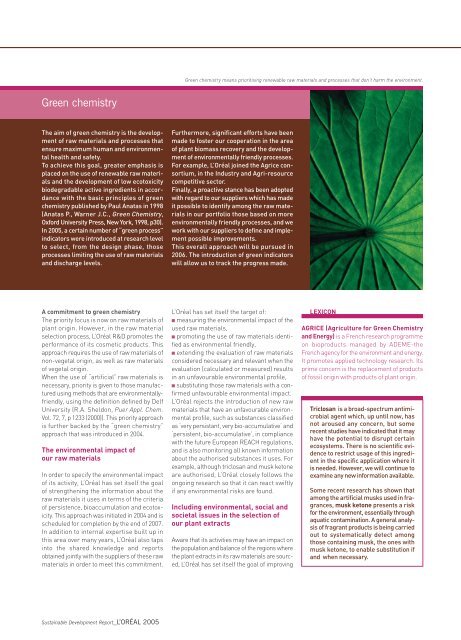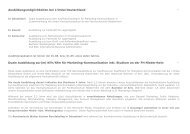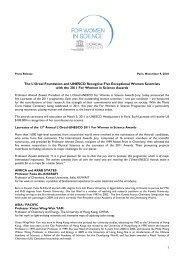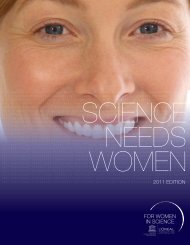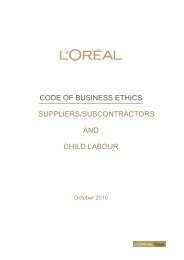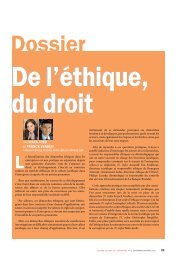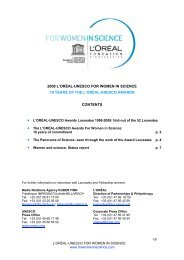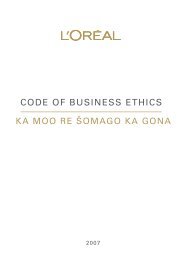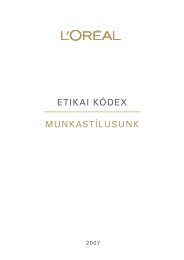2005 SUSTAINABLE DEVELOPMENT REPORT
2005 SUSTAINABLE DEVELOPMENT REPORT
2005 SUSTAINABLE DEVELOPMENT REPORT
Create successful ePaper yourself
Turn your PDF publications into a flip-book with our unique Google optimized e-Paper software.
Green chemistry<br />
The aim of green chemistry is the development<br />
of raw materials and processes that<br />
ensure maximum human and environmental<br />
health and safety.<br />
To achieve this goal, greater emphasis is<br />
placed on the use of renewable raw materials<br />
and the development of low ecotoxicity<br />
biodegradable active ingredients in accordance<br />
with the basic principles of green<br />
chemistry published by Paul Anatas in 1998<br />
(Anatas P., Warner J.C., Green Chemistry,<br />
Oxford University Press, New York, 1998, p30).<br />
In <strong>2005</strong>, a certain number of “green process”<br />
indicators were introduced at research level<br />
to select, from the design phase, those<br />
processes limiting the use of raw materials<br />
and discharge levels.<br />
A commitment to green chemistry<br />
The priority focus is now on raw materials of<br />
plant origin. However, in the raw material<br />
selection process, L’Oréal R&D promotes the<br />
performance of its cosmetic products. This<br />
approach requires the use of raw materials of<br />
non-vegetal origin, as well as raw materials<br />
of vegetal origin.<br />
When the use of “artificial” raw materials is<br />
necessary, priority is given to those manufactured<br />
using methods that are environmentallyfriendly,<br />
using the definition defined by Delf<br />
University (R.A. Sheldon, Puer Appl. Chem.<br />
Vol. 72, 7, p 1233 (2000)). This priority approach<br />
is further backed by the “green chemistry”<br />
approach that was introduced in 2004.<br />
The environmental impact of<br />
our raw materials<br />
In order to specify the environmental impact<br />
of its activity, L’Oréal has set itself the goal<br />
of strengthening the information about the<br />
raw materials it uses in terms of the criteria<br />
of persistence, bioaccumulation and ecotoxicity.<br />
This approach was initiated in 2004 and is<br />
scheduled for completion by the end of 2007.<br />
In addition to internal expertise built up in<br />
this area over many years, L’Oréal also taps<br />
into the shared knowledge and reports<br />
obtained jointly with the suppliers of these raw<br />
materials in order to meet this commitment.<br />
Sustainable Development Report_L’ORÉAL <strong>2005</strong><br />
Green chemistry means prioritising renewable raw materials and processes that don’t harm the environment.<br />
Furthermore, significant efforts have been<br />
made to foster our cooperation in the area<br />
of plant biomass recovery and the development<br />
of environmentally friendly processes.<br />
For example, L’Oréal joined the Agrice consortium,<br />
in the Industry and Agri-resource<br />
competitive sector.<br />
Finally, a proactive stance has been adopted<br />
with regard to our suppliers which has made<br />
it possible to identify among the raw materials<br />
in our portfolio those based on more<br />
environmentally friendly processes, and we<br />
work with our suppliers to define and implement<br />
possible improvements.<br />
This overall approach will be pursued in<br />
2006. The introduction of green indicators<br />
will allow us to track the progress made.<br />
L’Oréal has set itself the target of:<br />
■ measuring the environmental impact of the<br />
used raw materials,<br />
■ promoting the use of raw materials identified<br />
as environmental friendly,<br />
■ extending the evaluation of raw materials<br />
considered necessary and relevant when the<br />
evaluation (calculated or measured) results<br />
in an unfavourable environmental profile,<br />
■ substituting those raw materials with a confirmed<br />
unfavourable environmental impact.<br />
L’Oréal rejects the introduction of new raw<br />
materials that have an unfavourable environmental<br />
profile, such as substances classified<br />
as ‘very persistant, very bio-accumulative’ and<br />
‘persistent, bio-accumulative’, in compliance<br />
with the future European REACH regulations,<br />
and is also monitoring all known information<br />
about the authorised substances it uses. For<br />
example, although triclosan and musk ketone<br />
are authorised, L’Oréal closely follows the<br />
ongoing research so that it can react swiftly<br />
if any environmental risks are found.<br />
Including environmental, social and<br />
societal issues in the selection of<br />
our plant extracts<br />
Aware that its activities may have an impact on<br />
the population and balance of the regions where<br />
the plant extracts in its raw materials are sourced,<br />
L’Oréal has set itself the goal of improving<br />
LEXICON<br />
AGRICE (Agriculture for Green Chemistry<br />
and Energy) is a French research programme<br />
on bioproducts managed by ADEME-the<br />
French agency for the environment and energy.<br />
It promotes applied technology research. Its<br />
prime concern is the replacement of products<br />
of fossil origin with products of plant origin.<br />
Triclosan is a broad-spectrum antimicrobial<br />
agent which, up until now, has<br />
not aroused any concern, but some<br />
recent studies have indicated that it may<br />
have the potential to disrupt certain<br />
ecosystems. There is no scientific evidence<br />
to restrict usage of this ingredient<br />
in the specific application where it<br />
is needed. However, we will continue to<br />
examine any new information available.<br />
Some recent research has shown that<br />
among the artificial musks used in fragrances,<br />
musk ketone presents a risk<br />
for the environment, essentially through<br />
aquatic contamination. A general analysis<br />
of fragrant products is being carried<br />
out to systematically detect among<br />
those containing musk, the ones with<br />
musk ketone, to enable substitution if<br />
and when necessary.


